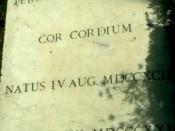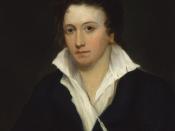In 'Ode to the West Wind,' Percy Bysshe Shelley tries to gain transcendence, for he
shows that his thoughts, like the 'winged seeds' (7) are trapped. The West Wind acts as a driving
force for change and rejuvenation in the human and natural world. Shelley views winter not just
as last phase of vegetation but as the last phase of life in the individual, the imagination,
civilization and religion. Being set in Autumn, Shelley observes the changing of the weather and
its effects on the internal and external environment. By examining this poem, the reader will see
that Shelley can only reach his sublime by having the wind carry his 'dead thoughts' (63) which
through an apocalyptic destruction, will lead to a rejuvenation of the imagination, the individual
and the natural world.
Shelley begins his poem by addressing the 'Wild West Wind' (1). He quickly introduces
the theme of death and compares the dead leaves to 'ghosts' (3).
The imagery of 'Pestilence-
stricken multitudes' makes the reader aware that Shelley is addressing more than a pile of leaves.
His claustrophobic mood becomes evident when he talks of the 'wintry bed' (6) and 'The winged
seeds, where they lie cold and low/ Each like a corpse within its grave, until/ Thine azure sister of
the Spring shall blow' (7-9). In the first line, Shelley use the phrase 'winged seeds' which
presents images of flying and freedom. The only problem is that they lay 'cold and low' or
unnourished or not elevated. He likens this with a feeling of being trapped. The important word
is 'seeds' for it shows that even in death, new life will grow out of the 'grave.' The phrase
'winged seeds' also brings images of religions, angels, and/or souls that continue to create new
life. Heavenly...


